中考英语专项复习第08讲形容词副词课件
图片预览
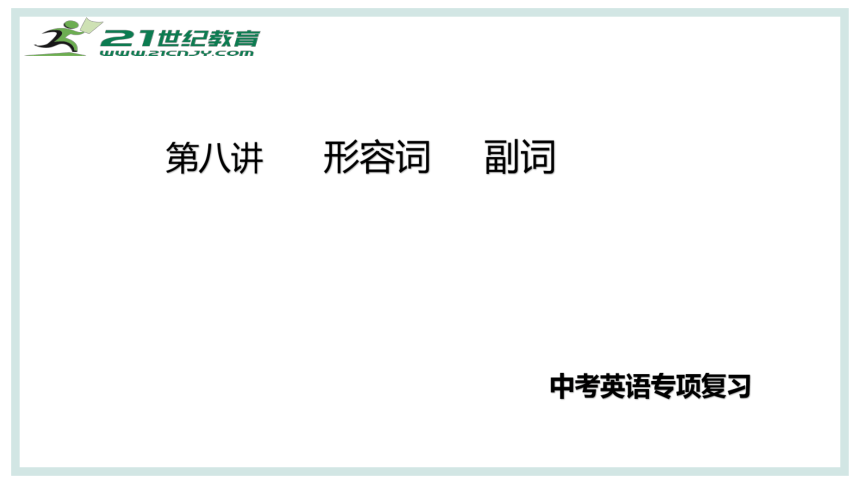
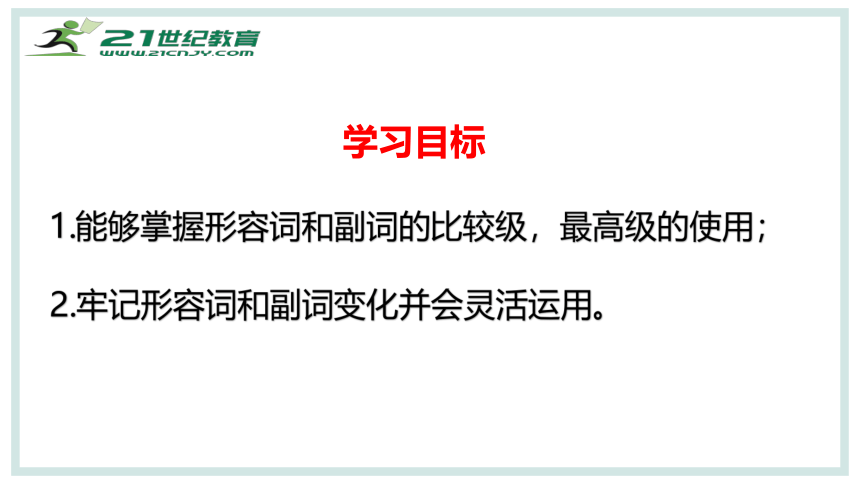
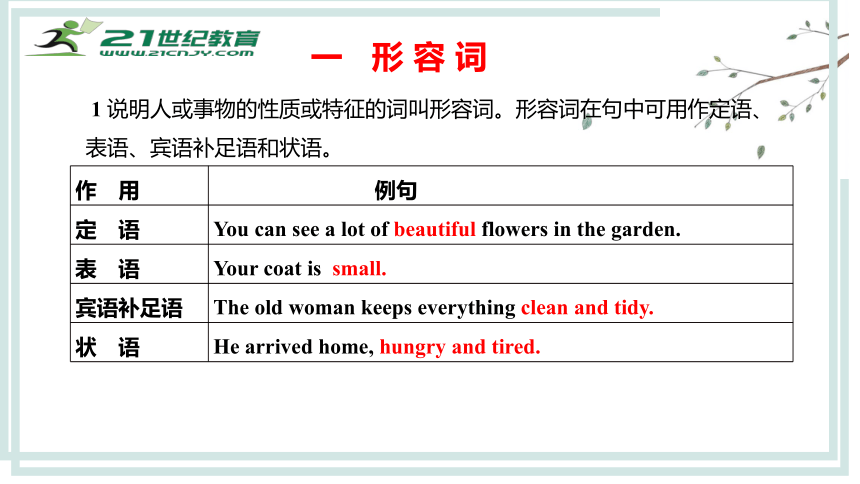
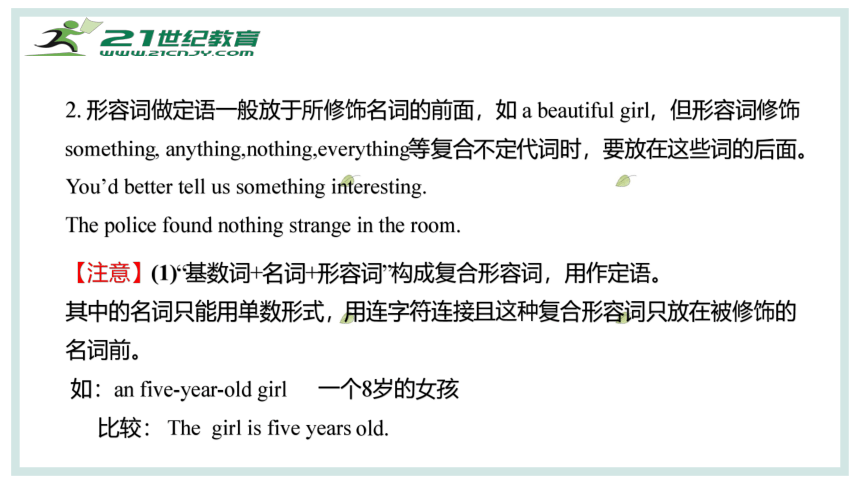
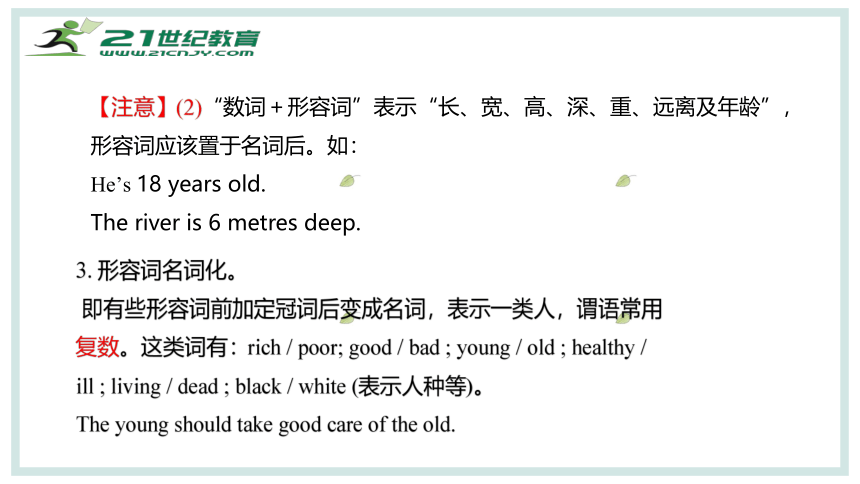
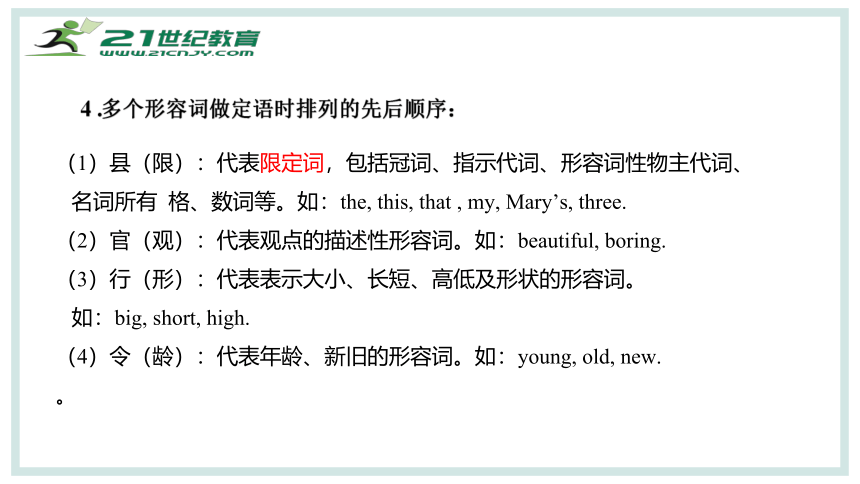
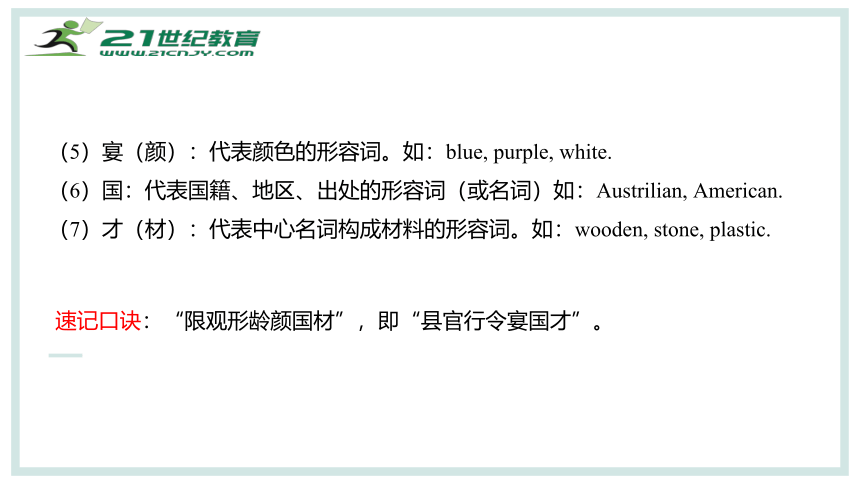
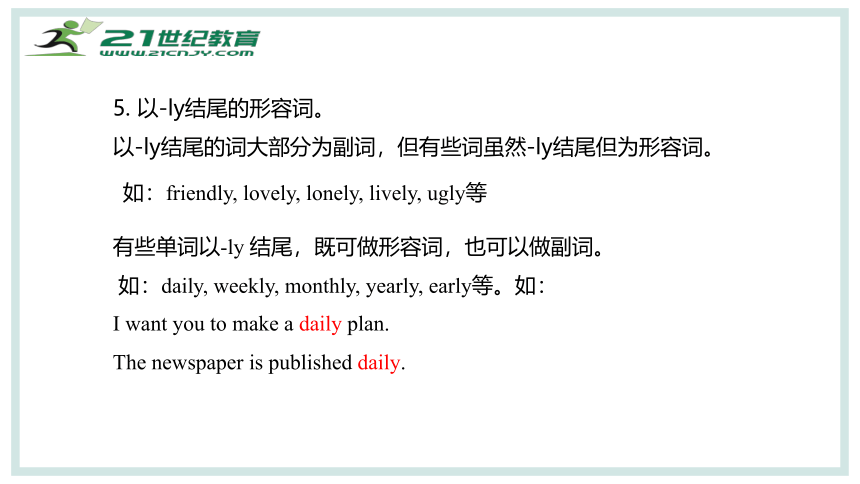

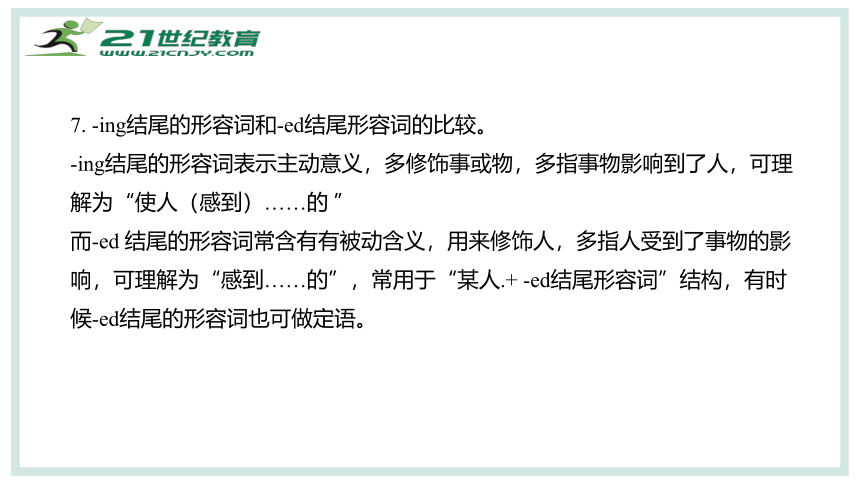

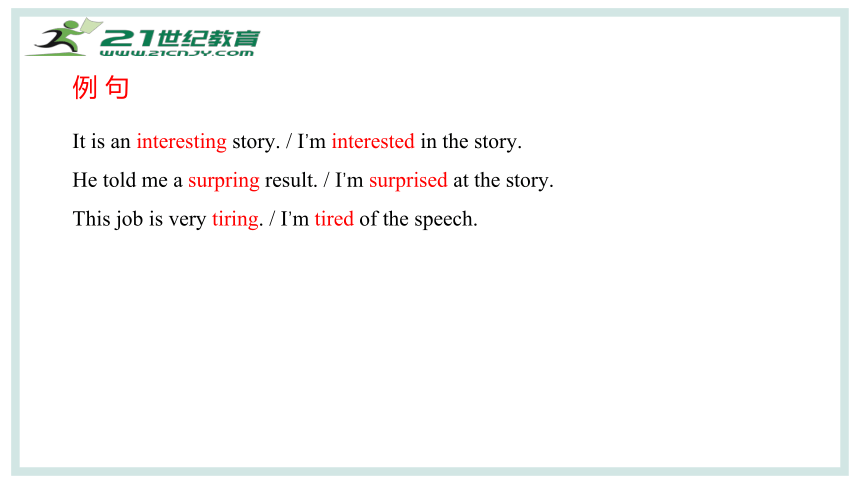
文档简介
(共49张PPT)
第八讲 形容词 副词
中考英语专项复习
1.能够掌握形容词和副词的比较级,最高级的使用;
2.牢记形容词和副词变化并会灵活运用。
学习目标
一 形 容 词
1 说明人或事物的性质或特征的词叫形容词。形容词在句中可用作定语、表语、宾语补足语和状语。
作 用 例句
定 语 You can see a lot of beautiful flowers in the garden.
表 语 Your coat is small.
宾语补足语 The old woman keeps everything clean and tidy.
状 语 He arrived home, hungry and tired.
2. 形容词做定语一般放于所修饰名词的前面,如 a beautiful girl,但形容词修饰something, anything,nothing,everything等复合不定代词时,要放在这些词的后面。
You’d better tell us something interesting.
The police found nothing strange in the room.
【注意】(1)“基数词+名词+形容词”构成复合形容词,用作定语。
其中的名词只能用单数形式,用连字符连接且这种复合形容词只放在被修饰的名词前。
如:an five-year-old girl 一个8岁的女孩
比较: The girl is five years old.
3. 形容词名词化。
即有些形容词前加定冠词后变成名词,表示一类人,谓语常用复数。这类词有:rich / poor; good / bad ; young / old ; healthy / ill ; living / dead ; black / white (表示人种等)。
The young should take good care of the old.
【注意】(2)“数词+形容词”表示“长、宽、高、深、重、远离及年龄”,形容词应该置于名词后。如:
He’s 18 years old.
The river is 6 metres deep.
4 .多个形容词做定语时排列的先后顺序:
(1)县(限):代表限定词,包括冠词、指示代词、形容词性物主代词、
名词所有 格、数词等。如:the, this, that , my, Mary’s, three.
(2)官(观):代表观点的描述性形容词。如:beautiful, boring.
(3)行(形):代表表示大小、长短、高低及形状的形容词。
如:big, short, high.
(4)令(龄):代表年龄、新旧的形容词。如:young, old, new.
。
文本信息
标题数字等都可以通过点击和重新输入进行更改。文字数字大小颜色参考此模板
(5)宴(颜):代表颜色的形容词。如:blue, purple, white.
(6)国:代表国籍、地区、出处的形容词(或名词)如:Austrilian, American.
(7)才(材):代表中心名词构成材料的形容词。如:wooden, stone, plastic.
速记口诀:“限观形龄颜国材”,即“县官行令宴国才”。
5. 以-ly结尾的形容词。
以-ly结尾的词大部分为副词,但有些词虽然-ly结尾但为形容词。
如:friendly, lovely, lonely, lively, ugly等
有些单词以-ly 结尾,既可做形容词,也可以做副词。
如:daily, weekly, monthly, yearly, early等。如:
I want you to make a daily plan.
The newspaper is published daily.
6. 只能作表语的形容词:
以下形容词:alone,afraid, awake, asleep,alive;; ill; frightened, well健康的等,只能用做表语。
如:(误)The ill boy is my brother.
( 正)The boy is ill.
7. -ing结尾的形容词和-ed结尾形容词的比较。
-ing结尾的形容词表示主动意义,多修饰事或物,多指事物影响到了人,可理解为“使人(感到)……的 ”
而-ed 结尾的形容词常含有有被动含义,用来修饰人,多指人受到了事物的影响,可理解为“感到……的”,常用于“某人.+ -ed结尾形容词”结构,有时候-ed结尾的形容词也可做定语。
-ing结尾的形容词 ed结尾的形容词
tiring 使人厌倦的 tired 感到疲倦的
exciting 使人激动的 excited 感到激动的
interesting 有趣的 interested 感兴趣的
surprising 使人惊讶的 surprised 感到惊讶的
moving 动人的 moved 受感动的
boring 令人厌烦的 bored 感到厌烦的
例 句
It is an interesting story. / I’m interested in the story.
He told me a surpring result. / I’m surprised at the story.
This job is very tiring. / I’m tired of the speech.
输入文本信息
标题数字等都可以通过点击和重新输入进行更改。文字数字大小颜色参考此模板
标题数字等都可以通过点击和重新输入进行更改。文字数字大小颜色参考此模板
8. 形容词常见的三个句型:
(1)It’s +adj.+of+sb.+to do不定式”表示“某人(做某事)怎么样”。
同义句:Sb. +be +adj+to do sth.
这个句型中的形容词常用描述行为者(人)的性格、品质的形容词。
如: kind, nice, polite, clever, foolish, lazy, careful, careless, good,wrong等。
It’s very kind of you to help me with English.
=You are very kind to help me with English.
(2)It’s+adj.+for+sb.+to do不定式”意思是“做某事对某人来说怎么样”
同义句:To do sth is adj for sb.
这个句型中的形容词常用描述做某事性质的形容词。
如: safe, useful, pleasant, interesting, impossible,important, necessary, difficult, easy, hard, dangerous,等。
It’s useful for us to learn a foreign language. =To learn a foreign language is useful for us.
输入标题文本信息
标题数字等都可以通过点击和重新输入进行更改。文字数字大小颜色参考此模板
(3)sb. find/make/think+it+形容词+to do sth. 意思是:某人发现/认为/使得做某事怎样。其中, 句中的it是形式宾语,不定式短语to do sth.为真正的宾语,形容词在句中作宾语补足语。
I found it difficult to finish the task.
二 副 词
1 修饰动词、形容词、其他副词或整个句子。用来说明事情发生的时间、地点、原因、方式等含义的词叫做副词
Unluckily, he lost his wallet.(修饰整个句子)
He walks slowly (修饰动词)
He runs too fast(too 为副词 修饰 fast 为副词)
2 副词的构成
大部分的副词是由形容词+后缀-ly构成的。其变化有以下几种方式。
(1)一般由形容词词尾加直接加-ly变成副词。如:quick→quickly, real→really, slow→slowly等。
(2)以“辅音字母+y”结尾的要变y为i再加-ly。如:happy→happily, angry→angrily, lucky→luckily, 等。
(3)以元音字母加辅音字母+e结尾的重读开音节,直接加-ly。如:wide→widely, polite→politely,safe→safely, 等。
(4)以元音字母加+e结尾,去e再加-ly。如:true→truly等。
(5)以辅音字母加-le结尾,去e再加-y。如:possible→possibly, terrible→terribly.comfortble-comfortbly等。
(6)形容词与副词同形。如:fast, high, hard, early等。
(7)形容词与副词异形。如:good→well等。
【注意】hard作形容词时意思是“困难的,硬的,生硬的”等;
作副词时意思是“努力地”。
hardly是否定副词,意思是“几乎不”。
3 副词的分类
(1)时间副词:通常用来表示动作发生的时间。一般的时间副词,尤其是表示具体时间的副词,放在句首或句尾。常见的时间副词:now, then, soon,, recently, lately, later, finally, today tomorrow, yesterday, tonight, still等。
(2)地点副词:通常用来表示动作发生的地点。地点副词常置于句尾,有时可置于句首,一般不置于句中。几个地点状语连用时,大地方放在最后。常见的地点副词有:here, there,upstairs,downstairs, home,anywhere,everywhere,somewhere,up ,down等。
点击此处
输入文本信息
(3)方式副词:一般都是回答“怎样地”。其中绝大部分都是由一个形容词加词尾-ly构成的。常见的方式副词有:carefully,happily,correctly, badly, proudly, rapidly, suddenly, successfully, angrily, hslowly, warmly, 也有形容词和副词同形的 如fast, hard等。
(4)程度副词:大多数用来修饰形容词和副词,有少数用来修饰动词或介词短语。程度副词常放在被修饰的动词、形容词或其他副词前面,但当very修饰动词时,常与 much连用并置于句末。常见的程度副词有:much, (a) little, a bit, very, so, too, enough, quite, rather, pretty, greatly, completely, nearly, almost, deeply, hardly, partly等。
(5)疑问副词:是用来引导特殊疑问句的副词。主要用来引导特殊疑问句,放在句首。常见的疑问副词有:how, when, where, why等。
(6)频度副词:是用来表示动作频率。常放在动词之前,或系动词、助动词、情态动词之后。其中sometimes也常置于句首。常见的频度副词有:always, often, never, usually, hardly, seldom(很少)等。
(7)连接副词:用来引导主语从句、宾语从句和表语从句,在从句中作状语,通常放在句子或从句前面。常见的连接副词有:so, yet, then, how, when, where, why, whether, however, otherwise, meanwhile等。
(8)关系副词:用来引导定语从句,在从句中作状语,放在从句的前面。常见的关系副词有:when, where, why, how等。
点击此处
输入文本信息
(1) 英语中副词的位置和汉语不尽相同,它的位置比较灵活。通常用作状语修饰动词、形容词、副词等;
(2) 多数副词都可以放在它所修饰的动词后; He runs slowly.
(3) 时间副词、地点副词和方式副词一般放在句末
They went to the park yesterday morning.
I heard him sing English songs over there.
【注意】有时表示时间的副词也可放在句首,起强调作用。
Yesterday I got up late.
4 副词的位置
点击此处
输入文本信息
(4)频率副词一般放在be动词、情态动词及第一个助动词之后,实义动词之前。
Do you usually go to school on foot.
He has never been to Beijing.
(5)有时 为了加强语气,频率副词也可放在句首。
Sometimes she goes to school by bus and sometimes she goes to school by bike.
(6) 程度副词修饰动词时,与频率副词相同,修饰形容词和副词时,放在它所
修饰的词前面。
I nearly missed the bus.
点击此处
输入文本信息
(7) 否定副词一般放在动词之前、系动词be或助动词之后。
She seldom goes out at night.
I am never late for school.
We had hardly got to the station when the train left.
(8) 疑问副词放在特殊疑问句的句首。When can you come
(9) 关系副词when, where, why 引导定语从句时,位于从句之前、所修饰的词之后。
Tell me the reason why you did it.
It’s the sort of day when you’d like to stay in bed.
I don’t know the place where we will go.
(10) 同时存在时间状语和地点状语时,时间状语一般放在后面。
The meeting will be held in the classroom tomorrow.
(11) 有些词既可用做形容词也可副词late, wide, well, fast, easy, early 等。
The road is so wide that 8 buses can go throw it at a time
Open your mouth wide.
三 形容词 副词的比较级和最高级
1 比较级和最高级的规则变化
①. 一般在词尾直接加er或est。如:small-smaller-smallest; long-longer-longest; 等。
②. 以不发音的字母e结尾的单词在词尾直接加r或st。如:nice-nicer-nicest, late-later-latest等。
③. 以辅音字母+y结尾的词,把y变为i,再加er或est。
如:heavy-heavier-heaviest; early-earlier-earliest等。
4. 重读闭音节,末尾只有一个辅音字母,双写这个辅音字母,再加er或est。如:big-bigger-biggest,red-redder-reddest等。类似的如(wet/hot/sad/thin/fat)
5. 部分双音节词和多音节词,分别是在原级前加more构成比较级和在原级前加most构成最高级。如: beautiful-more beautiful-most beautiful等。
【注意】表示否定意义的比较级和最高级可以在其前加less /least。如:important-less important-least important等。
6. 由“形容词+ly”构成的副词,分别是在原级前加more构成比较级和在原级前加most构成最高级。如:
slowly-more slowly-most slowly;quickly-more quickly- most quickly等。但early(形容词)-earlier-earliest例外。
【注意】有些形容词如:dead, empty, sure, round, woolen等无比较级和最高级。
2 比较级最高级不规则变化
原 级 比较级 最高级
good好的 更好的 最好的
well好;(身体)好的 bad,badly糟糕的,糟糕地 更糟糕的,更糟糕地;(身体)更不舒服的 最糟糕的,最糟糕地;
(身体)最不舒服的
ill(身体)不舒服的 many许多的(可数) 更多的;更 最多的;最
much许多的(不可数);非常 little少的 更少的 最少的
old旧的,老的,年长的 较旧的,较老的 最旧的,最老的
较年长的 最年长的
far远的;远地 (指距离)更远的;更远地 (指距离)最远的/地
(指程度)进一步的/地 (指程度)最深刻的/地
四 形容词 副词比较等级的使用
1 原级的用法
① 讲述某人/物自身的情况时,用原级。只能修饰原级的词有:very, quite, so, too, rather。基本句型为:
It is very hot.
You run too fast.
He is so happy.
② 原级常用的句型结构
Ⅰ. 表示两者之间一样,没有差别时,即A= B,常用句型:
“A +谓语动词+as+形容词/副词原级+as+B+其它.”
She is as tall as her sister.
Ⅱ 表示A比不上B时,即A<B,使用句型:
“A+谓语动词(否定式)+as/so+形容词/副词原级+as+B+其它.”(so只能用于否定句中,as既可以用于肯定句也可以用于否定句中)
He runs not so/as fast as his classmates.
【注意】①在as ... as结构中,若形容词作定语修饰单数可数名词,不定冠词a (an)应置于形容词和名词之间,不可放在形容词之前。
即as + adj.+ a/an+可数名词单数 +as
as…as结构前可用just, almost, nearly, quite等表示程度的词修饰。
She is as good a teacher as your father. 她和你的父亲一样是个好老师。
② as much+不可数名词+as+ 其它
as many+可数名词复数+as +其它
意思: 和……一样多的某物
Bob read as many books as Mary.
There is as much water in this bottle as in that bottle.
Ⅲ 表示“相当于……的一半/两倍/三倍……”等时,用“half/twice/three/four/…times as+形容词原级+as”句型。
This book is half as thick as that one.
This garden is ten times as large as that one.
This room is twice as big as that one..
2 比较级的用法
(1)比较常见句型结构
①两者进行比较,用注意用比较级。
基本句型为:“A+谓语动词(系动词)+形容词/副词比较级+than+B+ 其它”。连词than后可接句子,也可接名词、代词、名词短语、介词短语、动词、动词不定式、-ing结构和-ed结构,有时也可省去than
Lesson One is easier than Lesson Two
注意:than前后两项相比较的人或事物要一致。
My pencil is shorter than yours (your pencil).
表示两个人或事物之间的比较
② “the+比较级+of the two”表示“两者中较……的一个”。
He is the taller of the two boys.
③“比较级+ and+比较级”表示“越来越……”。
注意多音节形容词或副词用“more and more+多音节形容词或副词原级”
warmer and warmer.
more and more important.
④ “The + 比较级+主语+谓语, the + 比较级+主语+谓语+”表示:越……越……,越……就越……”
The more trees we plant, the better it will be.
The harder you try, the greater your progress is.
⑤“特殊疑问词+be+形容词/副词的比较级+甲or乙?”用于两者之间的比较
Which do you like better, the blue dress or the white one 。
⑥ 用比较级表示最高级含义的常用句型有:
比较级+than+any other+单数名词。
He is taller than any other boy in his class.=He is taller than(any of)the other boys in his class.=He is the tallest boy in his class.
比较级+than+the other+复数名词。
Mike is taller than the other boys in our class.
比较级+than+anyone else。
Tom is taller than anyone else in our class.
.
比较级+than+all other+复数名词。
This building is higher than all other buildings in S航海.
Nobody else+比较级+than …。
Nobody else is taller than Tom in our class.
有关的否定词+比较级。如:
No other books has had a greater influence on my work and study.
I never read a more interesting book
⑦ 可以修饰比较级的副词:
两多much (…得多)a lot (…得多)
两少 a little (一点儿) a bit (一点儿)
两甚至 even (甚至) still ( 仍然 )
还有一个远去了far (…得多)
Tom looks a little younger than before.
She drives still more carefully than her husband
三 最高级的使用方法
1 最高级常用句型结构
(1) 主语 +the+最高级+in/of/amomg短语” 表示: “……是……中最……的”。
Tom is the tallest in his class/of all the students.
This apple is the biggest of the five.
He is the best among the students.
【注意】形容词的最高级前通常加定冠词the, 副词的最高级前定冠词the 通常可以省略。
表示三者或三者以上进行比较用最高级
(2) “主语+be +one of the+形容词最高级+复数名词,表示:“…是…中最…之一”。
Beijing is one of the largest cities in China.
(3) “特殊疑问词+the+最高级 +甲,乙,or丙?” 用于三者及以上的比较。
Which season do you like (the) best,spring,summer or autumn?
⑴ 副词的最高级前the 可省掉。
如:Of all the boys he came (the) earliest.
⑵ 形容词最高级前一般要加定冠词the,但如果形容词最高级前有物主代词、指示代词、名词所有格修饰时,其前不加the;若两个最高级并列使用,后一个最高级前也可以不加the。
⑶ most 同形容词连用而不用 the,表示“极,很,非常,十分”。
2. 最高级的用法注意事项
⑷ 最高级可被序数词及much, by far, nearly, almost, by no means, not quite, not really, nothing like等词语所修饰。
He is our best friend. (有形容词物主代词,省略the)
She is the youngest and shortest girl in our class. (省略第二个the)
It’s most dangerous to be here. (十分危险)
This hat is by far/much/nearly/almost/not nearly/by no means/not quite/nothing like the biggest.
The Yellow River is the second longest river in China.(被修饰词修饰)
五 实 战 演 练
1. It is impossible for so _________ people to do so ________ work in a single day.
A. few;much B. few;many C. little;much D. little;many
2. After the new technique was introduced,the factory produced_________ cars in 2023 as the year before.
A. as twice many B. as many C. twice as many D. twice many as
3.(2023·山东青岛·统考中考真题)We should eat ________ fruit and vegetables to keep healthy.
A.free B.fresh C.soft D.sweet
A
c
B
4. Because she was late again for school, the teacher became __________.
A. very angrily B. much angry C. very angry
5. The_______ you do for others, the _______ you will feel.
A. much; happier B. more; happier C.most; happier D.more; happiest
C
B
6.(2023·辽宁丹东·统考中考真题)Jim can carry the heavy box because he is much _____ than the others in his class.
A.stronger B.thinner C.smaller D.weaker
C
7.(2023·四川遂宁·中考真题)—Give me a hand, Jim. I have to climb up the tree to get my kite.
—Better not. You have to take your safety __________.
A.seriously B.completely C.comfortably D.slowly
8.(2023·辽宁·统考中考真题)My mother was very happy because she bought a beautiful scarf ________ online.
A.cheaply B.badly C.actively D.safely
A
A
谢谢
21世纪教育网(www.21cnjy.com)
中小学教育资源网站
兼职招聘:
https://www.21cnjy.com/recruitment/home/admin
第八讲 形容词 副词
中考英语专项复习
1.能够掌握形容词和副词的比较级,最高级的使用;
2.牢记形容词和副词变化并会灵活运用。
学习目标
一 形 容 词
1 说明人或事物的性质或特征的词叫形容词。形容词在句中可用作定语、表语、宾语补足语和状语。
作 用 例句
定 语 You can see a lot of beautiful flowers in the garden.
表 语 Your coat is small.
宾语补足语 The old woman keeps everything clean and tidy.
状 语 He arrived home, hungry and tired.
2. 形容词做定语一般放于所修饰名词的前面,如 a beautiful girl,但形容词修饰something, anything,nothing,everything等复合不定代词时,要放在这些词的后面。
You’d better tell us something interesting.
The police found nothing strange in the room.
【注意】(1)“基数词+名词+形容词”构成复合形容词,用作定语。
其中的名词只能用单数形式,用连字符连接且这种复合形容词只放在被修饰的名词前。
如:an five-year-old girl 一个8岁的女孩
比较: The girl is five years old.
3. 形容词名词化。
即有些形容词前加定冠词后变成名词,表示一类人,谓语常用复数。这类词有:rich / poor; good / bad ; young / old ; healthy / ill ; living / dead ; black / white (表示人种等)。
The young should take good care of the old.
【注意】(2)“数词+形容词”表示“长、宽、高、深、重、远离及年龄”,形容词应该置于名词后。如:
He’s 18 years old.
The river is 6 metres deep.
4 .多个形容词做定语时排列的先后顺序:
(1)县(限):代表限定词,包括冠词、指示代词、形容词性物主代词、
名词所有 格、数词等。如:the, this, that , my, Mary’s, three.
(2)官(观):代表观点的描述性形容词。如:beautiful, boring.
(3)行(形):代表表示大小、长短、高低及形状的形容词。
如:big, short, high.
(4)令(龄):代表年龄、新旧的形容词。如:young, old, new.
。
文本信息
标题数字等都可以通过点击和重新输入进行更改。文字数字大小颜色参考此模板
(5)宴(颜):代表颜色的形容词。如:blue, purple, white.
(6)国:代表国籍、地区、出处的形容词(或名词)如:Austrilian, American.
(7)才(材):代表中心名词构成材料的形容词。如:wooden, stone, plastic.
速记口诀:“限观形龄颜国材”,即“县官行令宴国才”。
5. 以-ly结尾的形容词。
以-ly结尾的词大部分为副词,但有些词虽然-ly结尾但为形容词。
如:friendly, lovely, lonely, lively, ugly等
有些单词以-ly 结尾,既可做形容词,也可以做副词。
如:daily, weekly, monthly, yearly, early等。如:
I want you to make a daily plan.
The newspaper is published daily.
6. 只能作表语的形容词:
以下形容词:alone,afraid, awake, asleep,alive;; ill; frightened, well健康的等,只能用做表语。
如:(误)The ill boy is my brother.
( 正)The boy is ill.
7. -ing结尾的形容词和-ed结尾形容词的比较。
-ing结尾的形容词表示主动意义,多修饰事或物,多指事物影响到了人,可理解为“使人(感到)……的 ”
而-ed 结尾的形容词常含有有被动含义,用来修饰人,多指人受到了事物的影响,可理解为“感到……的”,常用于“某人.+ -ed结尾形容词”结构,有时候-ed结尾的形容词也可做定语。
-ing结尾的形容词 ed结尾的形容词
tiring 使人厌倦的 tired 感到疲倦的
exciting 使人激动的 excited 感到激动的
interesting 有趣的 interested 感兴趣的
surprising 使人惊讶的 surprised 感到惊讶的
moving 动人的 moved 受感动的
boring 令人厌烦的 bored 感到厌烦的
例 句
It is an interesting story. / I’m interested in the story.
He told me a surpring result. / I’m surprised at the story.
This job is very tiring. / I’m tired of the speech.
输入文本信息
标题数字等都可以通过点击和重新输入进行更改。文字数字大小颜色参考此模板
标题数字等都可以通过点击和重新输入进行更改。文字数字大小颜色参考此模板
8. 形容词常见的三个句型:
(1)It’s +adj.+of+sb.+to do不定式”表示“某人(做某事)怎么样”。
同义句:Sb. +be +adj+to do sth.
这个句型中的形容词常用描述行为者(人)的性格、品质的形容词。
如: kind, nice, polite, clever, foolish, lazy, careful, careless, good,wrong等。
It’s very kind of you to help me with English.
=You are very kind to help me with English.
(2)It’s+adj.+for+sb.+to do不定式”意思是“做某事对某人来说怎么样”
同义句:To do sth is adj for sb.
这个句型中的形容词常用描述做某事性质的形容词。
如: safe, useful, pleasant, interesting, impossible,important, necessary, difficult, easy, hard, dangerous,等。
It’s useful for us to learn a foreign language. =To learn a foreign language is useful for us.
输入标题文本信息
标题数字等都可以通过点击和重新输入进行更改。文字数字大小颜色参考此模板
(3)sb. find/make/think+it+形容词+to do sth. 意思是:某人发现/认为/使得做某事怎样。其中, 句中的it是形式宾语,不定式短语to do sth.为真正的宾语,形容词在句中作宾语补足语。
I found it difficult to finish the task.
二 副 词
1 修饰动词、形容词、其他副词或整个句子。用来说明事情发生的时间、地点、原因、方式等含义的词叫做副词
Unluckily, he lost his wallet.(修饰整个句子)
He walks slowly (修饰动词)
He runs too fast(too 为副词 修饰 fast 为副词)
2 副词的构成
大部分的副词是由形容词+后缀-ly构成的。其变化有以下几种方式。
(1)一般由形容词词尾加直接加-ly变成副词。如:quick→quickly, real→really, slow→slowly等。
(2)以“辅音字母+y”结尾的要变y为i再加-ly。如:happy→happily, angry→angrily, lucky→luckily, 等。
(3)以元音字母加辅音字母+e结尾的重读开音节,直接加-ly。如:wide→widely, polite→politely,safe→safely, 等。
(4)以元音字母加+e结尾,去e再加-ly。如:true→truly等。
(5)以辅音字母加-le结尾,去e再加-y。如:possible→possibly, terrible→terribly.comfortble-comfortbly等。
(6)形容词与副词同形。如:fast, high, hard, early等。
(7)形容词与副词异形。如:good→well等。
【注意】hard作形容词时意思是“困难的,硬的,生硬的”等;
作副词时意思是“努力地”。
hardly是否定副词,意思是“几乎不”。
3 副词的分类
(1)时间副词:通常用来表示动作发生的时间。一般的时间副词,尤其是表示具体时间的副词,放在句首或句尾。常见的时间副词:now, then, soon,, recently, lately, later, finally, today tomorrow, yesterday, tonight, still等。
(2)地点副词:通常用来表示动作发生的地点。地点副词常置于句尾,有时可置于句首,一般不置于句中。几个地点状语连用时,大地方放在最后。常见的地点副词有:here, there,upstairs,downstairs, home,anywhere,everywhere,somewhere,up ,down等。
点击此处
输入文本信息
(3)方式副词:一般都是回答“怎样地”。其中绝大部分都是由一个形容词加词尾-ly构成的。常见的方式副词有:carefully,happily,correctly, badly, proudly, rapidly, suddenly, successfully, angrily, hslowly, warmly, 也有形容词和副词同形的 如fast, hard等。
(4)程度副词:大多数用来修饰形容词和副词,有少数用来修饰动词或介词短语。程度副词常放在被修饰的动词、形容词或其他副词前面,但当very修饰动词时,常与 much连用并置于句末。常见的程度副词有:much, (a) little, a bit, very, so, too, enough, quite, rather, pretty, greatly, completely, nearly, almost, deeply, hardly, partly等。
(5)疑问副词:是用来引导特殊疑问句的副词。主要用来引导特殊疑问句,放在句首。常见的疑问副词有:how, when, where, why等。
(6)频度副词:是用来表示动作频率。常放在动词之前,或系动词、助动词、情态动词之后。其中sometimes也常置于句首。常见的频度副词有:always, often, never, usually, hardly, seldom(很少)等。
(7)连接副词:用来引导主语从句、宾语从句和表语从句,在从句中作状语,通常放在句子或从句前面。常见的连接副词有:so, yet, then, how, when, where, why, whether, however, otherwise, meanwhile等。
(8)关系副词:用来引导定语从句,在从句中作状语,放在从句的前面。常见的关系副词有:when, where, why, how等。
点击此处
输入文本信息
(1) 英语中副词的位置和汉语不尽相同,它的位置比较灵活。通常用作状语修饰动词、形容词、副词等;
(2) 多数副词都可以放在它所修饰的动词后; He runs slowly.
(3) 时间副词、地点副词和方式副词一般放在句末
They went to the park yesterday morning.
I heard him sing English songs over there.
【注意】有时表示时间的副词也可放在句首,起强调作用。
Yesterday I got up late.
4 副词的位置
点击此处
输入文本信息
(4)频率副词一般放在be动词、情态动词及第一个助动词之后,实义动词之前。
Do you usually go to school on foot.
He has never been to Beijing.
(5)有时 为了加强语气,频率副词也可放在句首。
Sometimes she goes to school by bus and sometimes she goes to school by bike.
(6) 程度副词修饰动词时,与频率副词相同,修饰形容词和副词时,放在它所
修饰的词前面。
I nearly missed the bus.
点击此处
输入文本信息
(7) 否定副词一般放在动词之前、系动词be或助动词之后。
She seldom goes out at night.
I am never late for school.
We had hardly got to the station when the train left.
(8) 疑问副词放在特殊疑问句的句首。When can you come
(9) 关系副词when, where, why 引导定语从句时,位于从句之前、所修饰的词之后。
Tell me the reason why you did it.
It’s the sort of day when you’d like to stay in bed.
I don’t know the place where we will go.
(10) 同时存在时间状语和地点状语时,时间状语一般放在后面。
The meeting will be held in the classroom tomorrow.
(11) 有些词既可用做形容词也可副词late, wide, well, fast, easy, early 等。
The road is so wide that 8 buses can go throw it at a time
Open your mouth wide.
三 形容词 副词的比较级和最高级
1 比较级和最高级的规则变化
①. 一般在词尾直接加er或est。如:small-smaller-smallest; long-longer-longest; 等。
②. 以不发音的字母e结尾的单词在词尾直接加r或st。如:nice-nicer-nicest, late-later-latest等。
③. 以辅音字母+y结尾的词,把y变为i,再加er或est。
如:heavy-heavier-heaviest; early-earlier-earliest等。
4. 重读闭音节,末尾只有一个辅音字母,双写这个辅音字母,再加er或est。如:big-bigger-biggest,red-redder-reddest等。类似的如(wet/hot/sad/thin/fat)
5. 部分双音节词和多音节词,分别是在原级前加more构成比较级和在原级前加most构成最高级。如: beautiful-more beautiful-most beautiful等。
【注意】表示否定意义的比较级和最高级可以在其前加less /least。如:important-less important-least important等。
6. 由“形容词+ly”构成的副词,分别是在原级前加more构成比较级和在原级前加most构成最高级。如:
slowly-more slowly-most slowly;quickly-more quickly- most quickly等。但early(形容词)-earlier-earliest例外。
【注意】有些形容词如:dead, empty, sure, round, woolen等无比较级和最高级。
2 比较级最高级不规则变化
原 级 比较级 最高级
good好的 更好的 最好的
well好;(身体)好的 bad,badly糟糕的,糟糕地 更糟糕的,更糟糕地;(身体)更不舒服的 最糟糕的,最糟糕地;
(身体)最不舒服的
ill(身体)不舒服的 many许多的(可数) 更多的;更 最多的;最
much许多的(不可数);非常 little少的 更少的 最少的
old旧的,老的,年长的 较旧的,较老的 最旧的,最老的
较年长的 最年长的
far远的;远地 (指距离)更远的;更远地 (指距离)最远的/地
(指程度)进一步的/地 (指程度)最深刻的/地
四 形容词 副词比较等级的使用
1 原级的用法
① 讲述某人/物自身的情况时,用原级。只能修饰原级的词有:very, quite, so, too, rather。基本句型为:
It is very hot.
You run too fast.
He is so happy.
② 原级常用的句型结构
Ⅰ. 表示两者之间一样,没有差别时,即A= B,常用句型:
“A +谓语动词+as+形容词/副词原级+as+B+其它.”
She is as tall as her sister.
Ⅱ 表示A比不上B时,即A<B,使用句型:
“A+谓语动词(否定式)+as/so+形容词/副词原级+as+B+其它.”(so只能用于否定句中,as既可以用于肯定句也可以用于否定句中)
He runs not so/as fast as his classmates.
【注意】①在as ... as结构中,若形容词作定语修饰单数可数名词,不定冠词a (an)应置于形容词和名词之间,不可放在形容词之前。
即as + adj.+ a/an+可数名词单数 +as
as…as结构前可用just, almost, nearly, quite等表示程度的词修饰。
She is as good a teacher as your father. 她和你的父亲一样是个好老师。
② as much+不可数名词+as+ 其它
as many+可数名词复数+as +其它
意思: 和……一样多的某物
Bob read as many books as Mary.
There is as much water in this bottle as in that bottle.
Ⅲ 表示“相当于……的一半/两倍/三倍……”等时,用“half/twice/three/four/…times as+形容词原级+as”句型。
This book is half as thick as that one.
This garden is ten times as large as that one.
This room is twice as big as that one..
2 比较级的用法
(1)比较常见句型结构
①两者进行比较,用注意用比较级。
基本句型为:“A+谓语动词(系动词)+形容词/副词比较级+than+B+ 其它”。连词than后可接句子,也可接名词、代词、名词短语、介词短语、动词、动词不定式、-ing结构和-ed结构,有时也可省去than
Lesson One is easier than Lesson Two
注意:than前后两项相比较的人或事物要一致。
My pencil is shorter than yours (your pencil).
表示两个人或事物之间的比较
② “the+比较级+of the two”表示“两者中较……的一个”。
He is the taller of the two boys.
③“比较级+ and+比较级”表示“越来越……”。
注意多音节形容词或副词用“more and more+多音节形容词或副词原级”
warmer and warmer.
more and more important.
④ “The + 比较级+主语+谓语, the + 比较级+主语+谓语+”表示:越……越……,越……就越……”
The more trees we plant, the better it will be.
The harder you try, the greater your progress is.
⑤“特殊疑问词+be+形容词/副词的比较级+甲or乙?”用于两者之间的比较
Which do you like better, the blue dress or the white one 。
⑥ 用比较级表示最高级含义的常用句型有:
比较级+than+any other+单数名词。
He is taller than any other boy in his class.=He is taller than(any of)the other boys in his class.=He is the tallest boy in his class.
比较级+than+the other+复数名词。
Mike is taller than the other boys in our class.
比较级+than+anyone else。
Tom is taller than anyone else in our class.
.
比较级+than+all other+复数名词。
This building is higher than all other buildings in S航海.
Nobody else+比较级+than …。
Nobody else is taller than Tom in our class.
有关的否定词+比较级。如:
No other books has had a greater influence on my work and study.
I never read a more interesting book
⑦ 可以修饰比较级的副词:
两多much (…得多)a lot (…得多)
两少 a little (一点儿) a bit (一点儿)
两甚至 even (甚至) still ( 仍然 )
还有一个远去了far (…得多)
Tom looks a little younger than before.
She drives still more carefully than her husband
三 最高级的使用方法
1 最高级常用句型结构
(1) 主语 +the+最高级+in/of/amomg短语” 表示: “……是……中最……的”。
Tom is the tallest in his class/of all the students.
This apple is the biggest of the five.
He is the best among the students.
【注意】形容词的最高级前通常加定冠词the, 副词的最高级前定冠词the 通常可以省略。
表示三者或三者以上进行比较用最高级
(2) “主语+be +one of the+形容词最高级+复数名词,表示:“…是…中最…之一”。
Beijing is one of the largest cities in China.
(3) “特殊疑问词+the+最高级 +甲,乙,or丙?” 用于三者及以上的比较。
Which season do you like (the) best,spring,summer or autumn?
⑴ 副词的最高级前the 可省掉。
如:Of all the boys he came (the) earliest.
⑵ 形容词最高级前一般要加定冠词the,但如果形容词最高级前有物主代词、指示代词、名词所有格修饰时,其前不加the;若两个最高级并列使用,后一个最高级前也可以不加the。
⑶ most 同形容词连用而不用 the,表示“极,很,非常,十分”。
2. 最高级的用法注意事项
⑷ 最高级可被序数词及much, by far, nearly, almost, by no means, not quite, not really, nothing like等词语所修饰。
He is our best friend. (有形容词物主代词,省略the)
She is the youngest and shortest girl in our class. (省略第二个the)
It’s most dangerous to be here. (十分危险)
This hat is by far/much/nearly/almost/not nearly/by no means/not quite/nothing like the biggest.
The Yellow River is the second longest river in China.(被修饰词修饰)
五 实 战 演 练
1. It is impossible for so _________ people to do so ________ work in a single day.
A. few;much B. few;many C. little;much D. little;many
2. After the new technique was introduced,the factory produced_________ cars in 2023 as the year before.
A. as twice many B. as many C. twice as many D. twice many as
3.(2023·山东青岛·统考中考真题)We should eat ________ fruit and vegetables to keep healthy.
A.free B.fresh C.soft D.sweet
A
c
B
4. Because she was late again for school, the teacher became __________.
A. very angrily B. much angry C. very angry
5. The_______ you do for others, the _______ you will feel.
A. much; happier B. more; happier C.most; happier D.more; happiest
C
B
6.(2023·辽宁丹东·统考中考真题)Jim can carry the heavy box because he is much _____ than the others in his class.
A.stronger B.thinner C.smaller D.weaker
C
7.(2023·四川遂宁·中考真题)—Give me a hand, Jim. I have to climb up the tree to get my kite.
—Better not. You have to take your safety __________.
A.seriously B.completely C.comfortably D.slowly
8.(2023·辽宁·统考中考真题)My mother was very happy because she bought a beautiful scarf ________ online.
A.cheaply B.badly C.actively D.safely
A
A
谢谢
21世纪教育网(www.21cnjy.com)
中小学教育资源网站
兼职招聘:
https://www.21cnjy.com/recruitment/home/admin
同课章节目录
- 词法
- 名词
- 动词和动词短语
- 动词语态
- 动词时态
- 助动词和情态动词
- 非谓语动词
- 冠词
- 代词
- 数词和量词
- 形容词副词及其比较等级
- 介词和介词短语
- 连词和感叹词
- 构词法
- 相似、相近词比较
- 句法
- 陈述句
- 一般疑问句和否定疑问句
- 特殊疑问句及选择疑问句
- 反意疑问句
- 存在句(There be句型)
- 宾语从句
- 定语从句
- 状语从句
- 主谓一致问题
- 简单句
- 并列句
- 复合句
- 主谓一致
- 主、表语从句
- 名词性从句
- 直接引语和间接引语
- 虚拟语气
- 感叹句
- 强调句
- 倒装句
- 祈使句
- 句子的成分
- 句子的分类
- 题型专区
- 单项选择部分
- 易错题
- 完形填空
- 阅读理解
- 词汇练习
- 听说训练
- 句型转换
- 补全对话
- 短文改错
- 翻译
- 书面表达
- 任务型阅读
- 语法填空
- 其他资料
